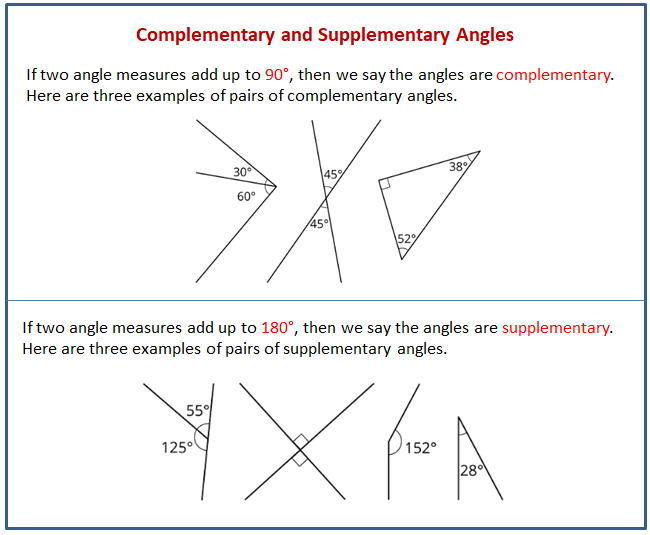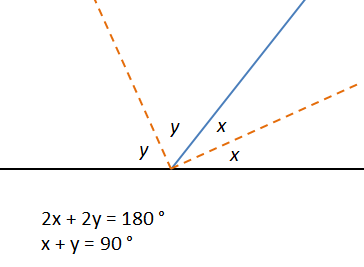Illustrative Mathematics Grade 7, Unit 7, Lesson 2: Adjacent Angles
Learning Targets:
- I can find unknown angle measures by reasoning about complementary or supplementary angles.
- I can recognize when adjacent angles are complementary or supplementary.
Related Pages
Illustrative Math
Grade 7
Lesson 2: Adjacent Angles
Let’s look at some special pairs of angles.
Illustrative Math Unit 7.7, Lesson 2 (printable worksheets)
Lesson 2 Summary
The following diagram shows some examples of complementary and supplementary angles.

Lesson 2.1 Estimating Angle Measures
Estimate the degree measure of each indicated angle.
Lesson 2.2 Cutting Rectangles
Your teacher will give you two small, rectangular papers.
- On one of the papers, draw a small half-circle in the middle of one side.
- Cut a straight line, starting from the center of the half-circle, all the way across the paper to make 2 separate pieces. (Your cut does not need to be perpendicular to the side of the paper.)
- On each of these two pieces, measure the angle that is marked by part of a circle. Label the angle measure on the piece.
- What do you notice about these angle measures?
- Clare measured 70 degrees on one of her pieces. Predict the angle measure of her other piece.
- On the other rectangular paper, draw a small quarter-circle in one of the corners. Repeat the previous steps to cut, measure, and label the two angles marked by part of a circle.
- Repeat the previous steps to cut, measure, and label the two angles marked by part of a circle.
- What do you notice about these angle measures?
- Priya measured 53 degrees on one of her pieces. Predict the angle measure of her other piece.
Lesson 2.3 Is It a Complement or Supplement?
- Use the protractor in the picture to find the measure of angles:
a. BCA
b. BCD
c. Explain how to find the measure of angle ACD without repositioning the protractor. - Use the protractor in the picture to find the measure of angles:
a. LOK
b. LOM
c. Explain how to find the measure of angle KOM without repositioning the protractor. - Angle BAC is a right angle. Find the measure of angle CAD.
- Point O is on line RS. Find the measure of angle SOP.
Are you ready for more?
Clare started with a rectangular piece of paper. She folded up one corner, and then folded up the other corner, as shown in the photos.
- Try this yourself with any rectangular paper. Fold the left corner up at any angle, and then fold the right corner up so that the edges of the paper meet.
- Clare thought that the angle at the bottom looked like a 90 degree angle. Does yours also look like it is 90 degrees?
- Can you explain why the bottom angle always has to be 90 degrees? Hint: the third photo shows Clare’s paper, unfolded. The crease marks have dashed lines, and the line where the two paper edges met have a solid line. Mark these on your own paper as well.
Lesson 2 Practice Problems
- Angles A and C are supplementary. Find the measure of angle C.
- a. List two pairs of angles in square CDFG that are complementary.
b. Name three angles that sum to 180°. - Complete the equation with a number that makes the expression on the right side of the equal sign equivalent to the expression on the left side.
5x - 2.5 + 6x - 3 = _ (2x - 1) - Match each table with the equation that represents the same proportional relationship.
The Open Up Resources math curriculum is free to download from the Open Up Resources website and is also available from Illustrative Mathematics.
Try out our new and fun Fraction Concoction Game.
Add and subtract fractions to make exciting fraction concoctions following a recipe. There are four levels of difficulty: Easy, medium, hard and insane. Practice the basics of fraction addition and subtraction or challenge yourself with the insane level.

We welcome your feedback, comments and questions about this site or page. Please submit your feedback or enquiries via our Feedback page.
